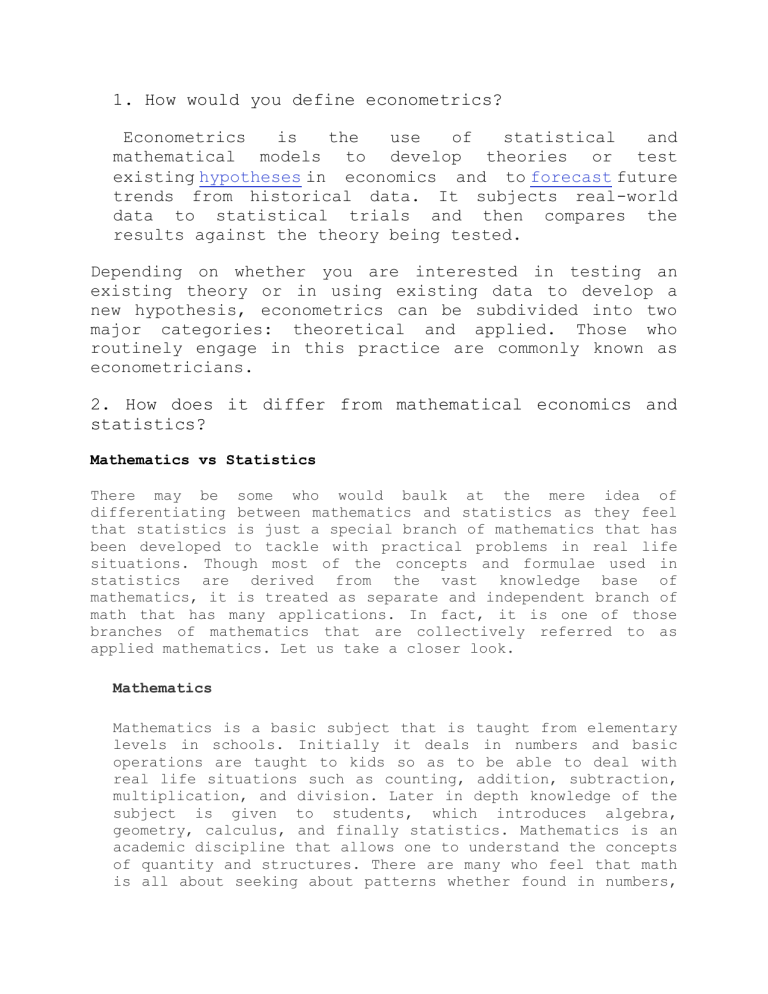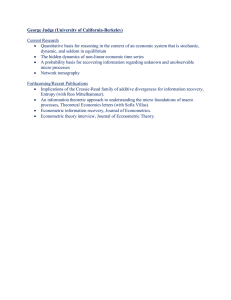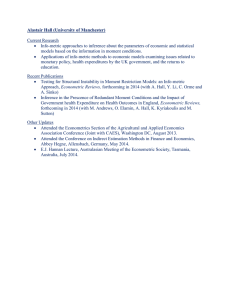
1. How would you define econometrics? Econometrics is the use of statistical and mathematical models to develop theories or test existing hypotheses in economics and to forecast future trends from historical data. It subjects real-world data to statistical trials and then compares the results against the theory being tested. Depending on whether you are interested in testing an existing theory or in using existing data to develop a new hypothesis, econometrics can be subdivided into two major categories: theoretical and applied. Those who routinely engage in this practice are commonly known as econometricians. 2. How does it differ from mathematical economics and statistics? Mathematics vs Statistics There may be some who would baulk at the mere idea of differentiating between mathematics and statistics as they feel that statistics is just a special branch of mathematics that has been developed to tackle with practical problems in real life situations. Though most of the concepts and formulae used in statistics are derived from the vast knowledge base of mathematics, it is treated as separate and independent branch of math that has many applications. In fact, it is one of those branches of mathematics that are collectively referred to as applied mathematics. Let us take a closer look. Mathematics Mathematics is a basic subject that is taught from elementary levels in schools. Initially it deals in numbers and basic operations are taught to kids so as to be able to deal with real life situations such as counting, addition, subtraction, multiplication, and division. Later in depth knowledge of the subject is given to students, which introduces algebra, geometry, calculus, and finally statistics. Mathematics is an academic discipline that allows one to understand the concepts of quantity and structures. There are many who feel that math is all about seeking about patterns whether found in numbers, science, space, computers, designs, architecture, and so on. Logical reasoning and application of theorems allows a student of math to find relations and to reason with the ability to authenticate their assumptions. Statistics If you look at colleges and universities, they seem to have two separate departments of mathematics and applied mathematics, and this is where differences between mathematics and statistics become easy to comprehend. Applied mathematics is widely used in research and has industrial applications. Statistics is that branch of mathematics that deals in probability, graphical representation of mathematical data, and interpretation of uncertain observation that is not possible with formulae and principles of mathematics, and so on. Statistics is mainly concerned with collection, analysis, explanation, and presentation of data. It also helps in forecasting and predicting results based upon insufficient data. Statistics finds applications in a wide variety of fields such as social sciences, governmental departments, businesses, investment practices, and stock markets besides helping those involved in betting. Statistics can improve the quality of any data and make interpretations from it easy. 3. Describe the main steps econometrics research. involved in any Major Steps in an Econometric Research Project Step 1: Formulate a methodologically sound research design, or research plan, that effectively utilizes the available sample data to provide credible empirical evidence on the empirical question(s) you are investigating. Requires knowledge and understanding of (1)the principles of econometric model specification and (2) the methods of estimation and inference in econometric models. (2) Step 2: Execute the research plan in accordance with good econometric practice – i.e., conduct the econometric analysis required to assemble credible empirical evidence on the empirical question(s) you were asked to investigate. Requires a good working knowledge of both econometric methods and econometric software. (3) Step 3: Write an accurate, complete, and logically coherent research report in which you fully and accurately explain what you did, how you did it, and what you found. Explaining what you did and how you did it involves: • Describing the sample data you used; • Specifying the econometric models you estimated; • Identifying the estimation methods you used; • Specifying the hypothesis tests you performed on each model. Reporting what you found involves: • Tabulating the results of your econometric analysis, including the coefficient estimates of all reported models and the results of all hypothesis tests performed on these models; • Interpreting and econometric analysis; explaining the results of your • Assessing the strength of the evidence you obtained on the empirical questions you were asked to investigate; • Identifying limitations of your analysis and suggestions for further research. Requires excellent organizational and technical writing skills. 4. Differentiate between economic and econometric model Economic model Econometric model -it shows the economic r/ship -it measures the value of b/n d/t economic variables. parameters in economic r/ship -the economic model is the theoretical construct that represents the complex economic process or association b/n economic variables. -an econometric model is the combination of mathematical statistical and economic concepts that represents the mathematical estimate of the variables or parameters there in the identified models. -economic models are qualitative but by nature they are based on mathematical models as they ignore residual variable. -econometric models is are extensively statistical or future forecast eriented and thus based on statistical models -economic models attempt to -econometric models focus on exhibit the logical r/ship b/n calculating the numerical d/t variables considered in values and direction of the model variables considered in the model 5. What are the goals of econometrics? Goal Number 1: Analysis Disclaimer: the example above is not suited to econometric analysis unless the econometrist examining those economic phenomena look at savings and borrowing trends across a population. And, even then, they would not make recommendations for individuals to follow but for policymakers raise or lower interest rates. - perhaps to It's impossible to formulate a statistic from a single data point. No matter the phenomenon under consideration, it takes lots of data points to create a statistic. Photo credit: whatsthatpicture on VisualHuntEconometrics cannot apply to individual situations because the discipline draws on statistics as well as economics, and involves the use of mathematics. However, that's just the type of information that econometrists consider when tasked with proving an economic theory. This process starts when a specific economic phenomenon comes under consideration. Throughout this article, we'll use the wage gap between workers with and without a university degree in a particular sector - maybe manufacturing or marketing and sales to illustrate salient points. To make the analysis more specific, the econometric theory written to address this question might specify to only consider workers of a certain age or level of experience in that field. That's because time on the job, particularly with the same company, is a variable that could influence workers' wages, too. Side note: find out how large a role theoretical econometrics plays in shaping economic policy worldwide... To start the analysis process, econometrists gather all of the relevant empirical evidence that tests the economic theory in question. Does the observed economic behaviour - the empirical evidence support the economic theory? More often than not, econometrists end up with a 'sliding scale' result. To reflect such an outcome in relatable terms, now... They will likely find that not every single worker within that that certain age group and/or level of experience will earn the same amount. For instance, workers living in big cities may earn more simply because their cost of living is higher and, thus, they get paid more. That is a variable that was not considered in our example; another is the size of the company they work for. Multinational companies can and usually do pay their workers more than smaller, homegrown concerns. Still, all other variables aside, after examining all of that data, a clear picture emerges of whether or not workers with a university degree earn more. That conclusion could have a wide range of consequences. Governments may make university education more affordable or provide grants and subsidies to those who cannot afford to continue learning. They may raise minimum wage, forcing employers to increase skilled workers' pay to maintain the gap between skilled and unskilled labour. Find more economics tutor here on Superprof. Goal Number 2: Supplying Estimates Some people might play around with linear regression just for the fun of it but most econometrists use the multiple linear regression model because they have been tasked to find information that addresses a specific economic concern. Usually, the bodies assigning those tasks are the same ones that set fiscal and economic policy for their country or group of countries. After econometrists have modelled all of the data applicable to the econometric theory they were given, they have to do something with the conclusions they've drawn. They can't simply throw a bunch of scatter plots on the table and claim their work is done; they have to explain their conclusions and provide concrete numbers that will help shape economic policy. That's why, before presenting their analyses, econometrists winnow their findings down to the coefficients of economic relationships, a simple numerical estimate that policymakers can use to decide how they'll move forward armed with the information at hand. Econometrists arrive at that number by using correlation coefficients to measure the strength of two variables' linear relationship. This model seems to prove that those who eat a lot of cheese are usually betrayed by their bedsheets! Photo credit: katexic on VisualHunt.com You may be familiar with the terms 'positive correlation' and its inverse, 'negative correlation'. If the correlation coefficient is more than zero, that number signals a positive correlation between the two variables. If the correlation coefficient is less than zero, their relationship is negative and if the correlation is zero - neither positive nor negative, there is no relationship between the two variables. Applying that knowledge to our wage gap hypothesis, now: the correlation coefficient is a positive number: wages increase the higher the education level the correlation coefficient is a negative number: the lower the education level, the higher the wage and vice versa the correlation coefficient is 0: the level of education has no impact on wages and wages do not reflect workers' education levels You might wonder how workers with a lower level of education could out-earn a university-educated worker. In fact, that happens much more often than you might think! Picture an entry-level manager with no university degree who, by virtue of a promotion, has moved from hourly wages to a salaried position. Unlike wager earners do, s/he won't earn any overtime and, because of that entry-level status, may not yet qualify for any bonuses. Of course, that is a vastly oversimplified example - suitable for this introduction to econometrics, but it does show how wage earners can out-earn management workers. And, overall, it gives a fair snapshot of how econometrists turn raw data into concrete numbers through quantitative analysis. Find various economics tutor here on Superprof. Goal Number 3: Forecasting After all of that modelling and analysis, you might think the econometrist's job is finished... but it isn't, yet. Now, they have to forecast what will happen if the current statistics continue in play and what policymakers should change to improve the economic outlook. How do they do that? Let's say there's a positive correlation between university education and wages in that particular industry. The logical conclusion is that, if more workers had a degree, they would earn more - meaning they would also spend (consume) more and pay more in taxes. Find more online tutor for economics here on Superprof. Those are two main reasons why policymakers consider this scenario, by the way. The OECD is just one policymaking body that relies on econometrists accurately forecasting economic phenomena. Photo credit: Organisation for Economic Co-operation and Develop on VisualhuntIn forecasting, econometrists consider risks that might impact the prosperity of an economic phenomenon, usually up to a set date in the future - maybe one year or five years, but often at smaller intervals. In our wage gap scenario, such risks might include a percentage of higher-paid employees finding work in other fields or retiring, less demand for employees in that field because that market is stagnant and how automation might reduce the need for workers. They select the variables most relevant to the economic question, develop statistical models to predict how those variables might behave. Conclusion Reaching the three goals of econometrics - analysing, estimating and forecasting, is exacting and demanding. Many entities concerned with economic policy rely on econometrists to achieve these goals so those policymakers can determine which direction to take in setting their economic goals and boosting economic performance. Those entities include the World Bank, the International Monetary Fund, and, of course, the Organisation for Economic Cooperation and Development or OECD. With that being said, we have to touch on the global economic downturn of 2008, an event that few forecasters saw coming. With all of that data scrutiny, how could they have missed the warning signs? Economists and econometrists struggle to explain that still today. And not just that event but the fallout from it, too, the effects of which are still being felt around the world. Now add to those residual effects to how the pandemic upended global economics... In light of that revelation, do you think econometrics should be accorded the importance it currently has?



